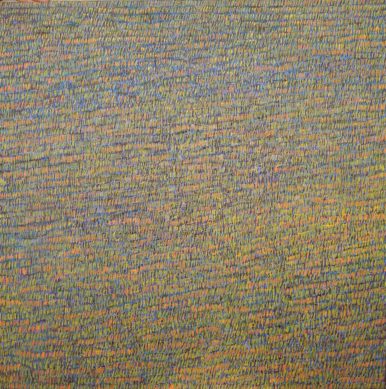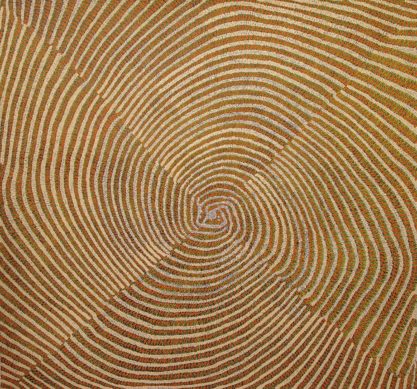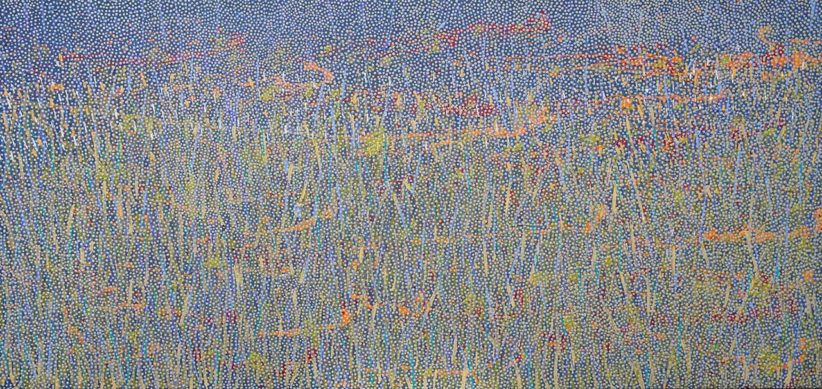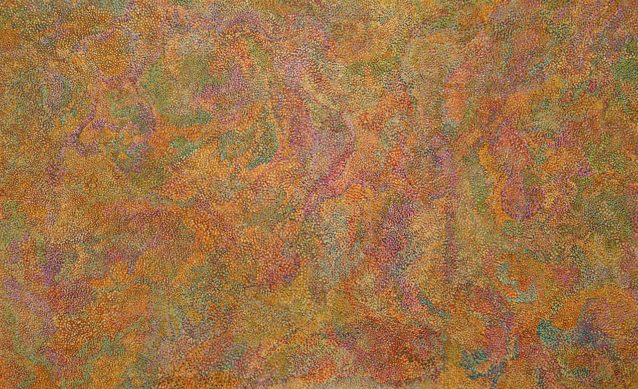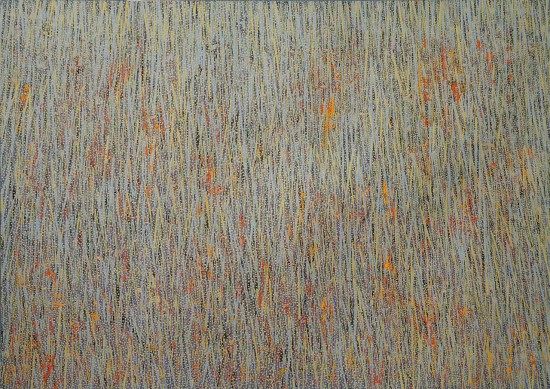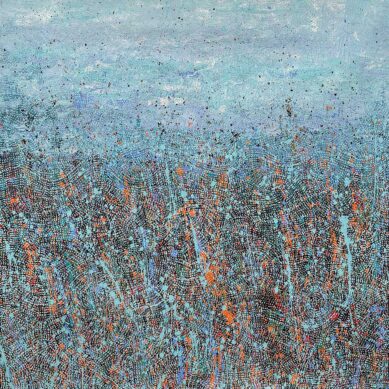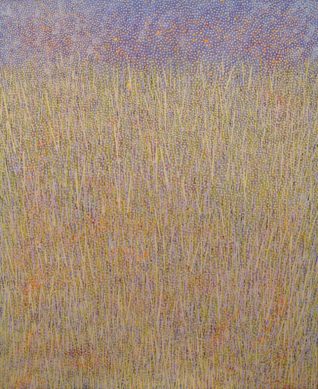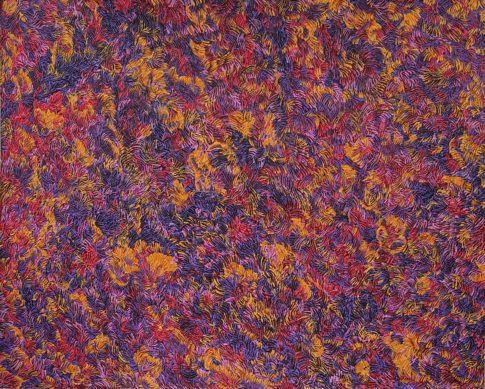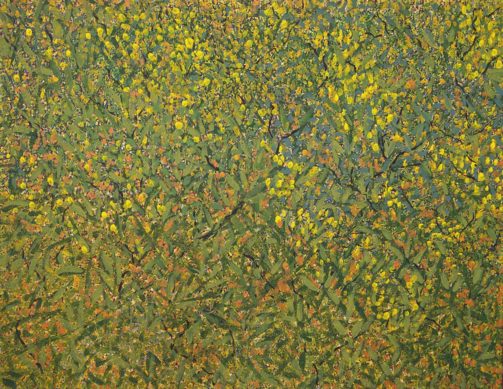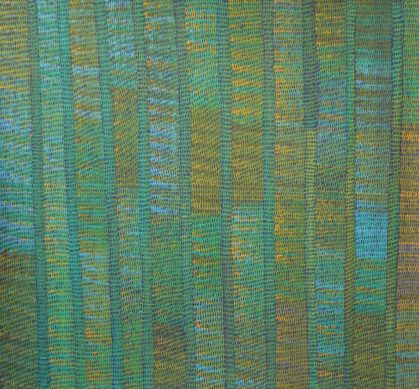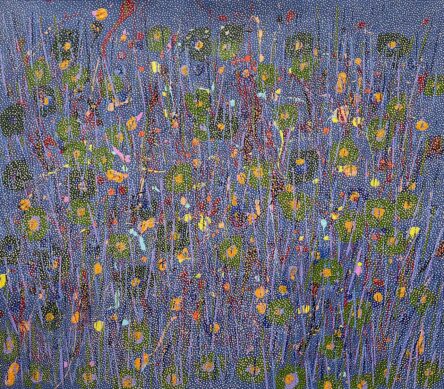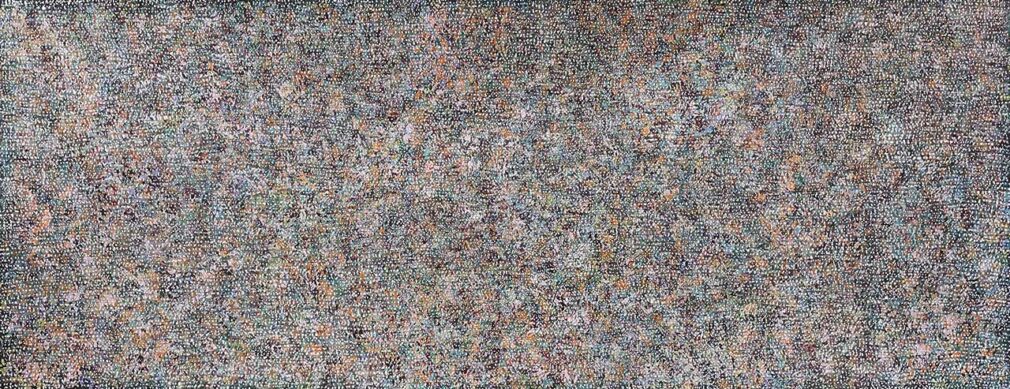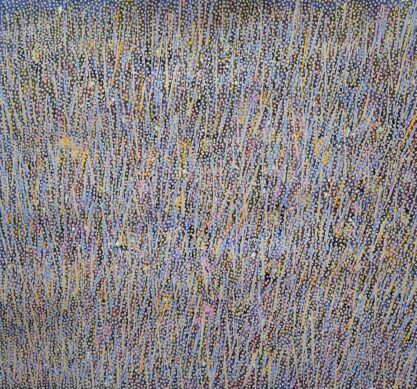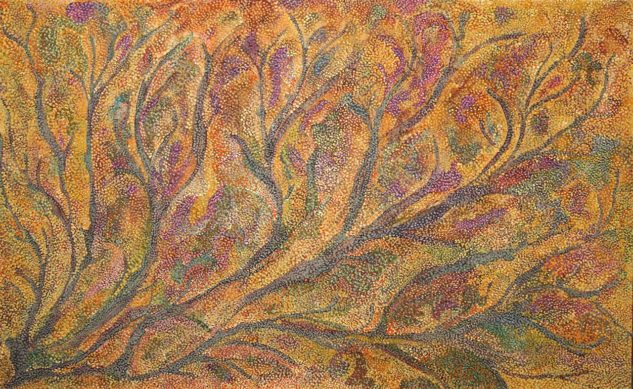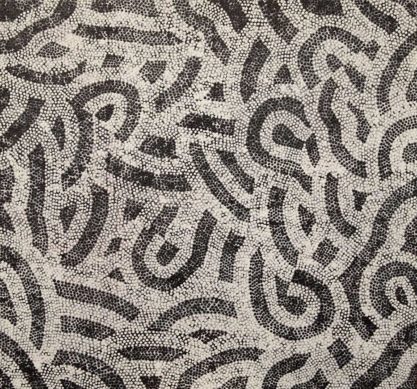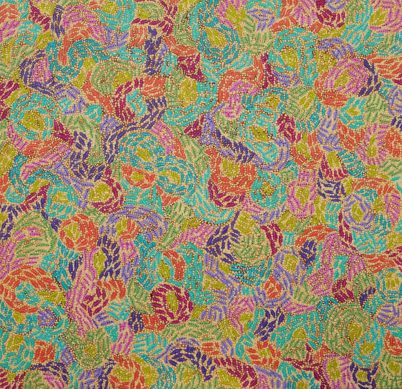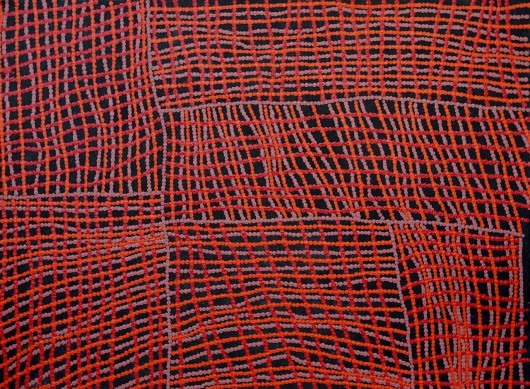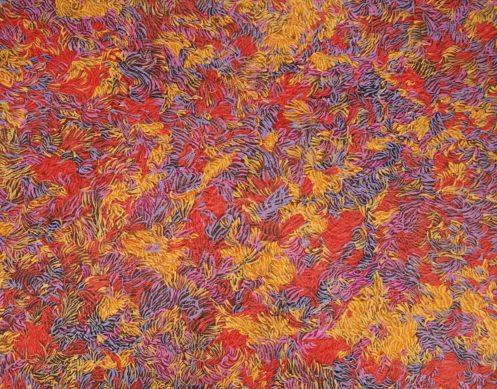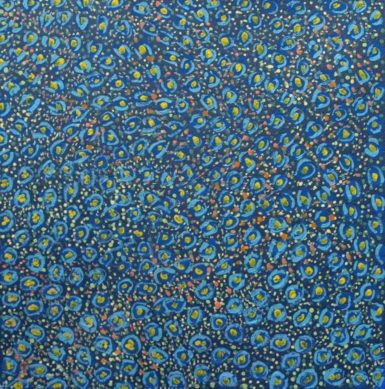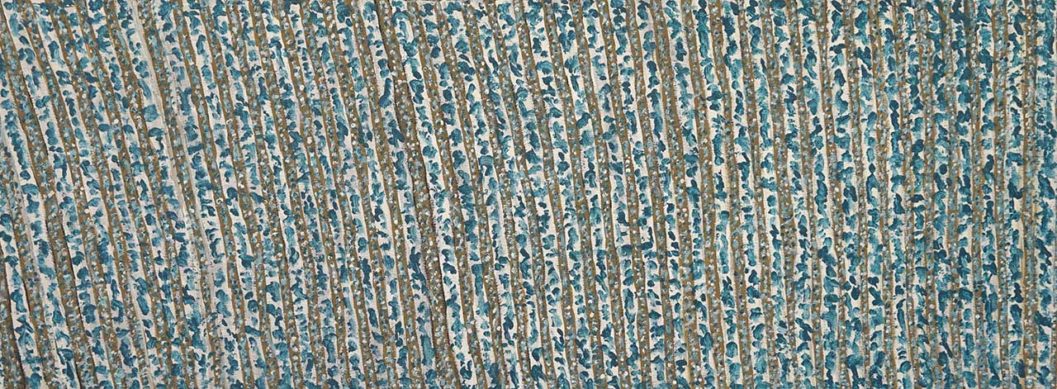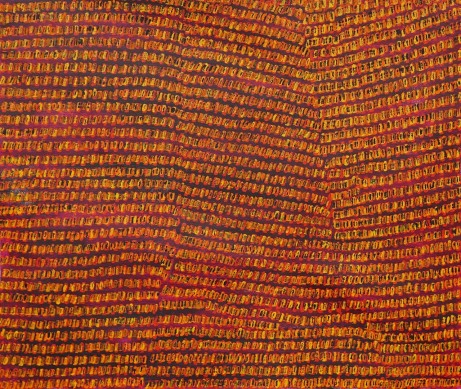Yinjaa-Barni Aboriginal Art
A selection of paintings showing the styles from this Aboriginal art region - some paintings may still be available for sale, while some may have been sold.
Yinjaa-Barni emerged as a significant Pilbara Aboriginal art centre based in Roebourne in the north-west of Western Australia. Its role was to promote the work of the first Indigenous artists who began working locally in 2001. The art centre is now located in Dalgety House, a heritage listed cottage on the main street of town, but prior to 2007 it operated from a shed at the back of the Aboriginal Church, where many of the artists are members. In the Yindjibarndi language yinjaa-barni means staying together.
Over the last few years the Aboriginal artists at Yinjaa-Barni have enjoyed growing success. Many have won major awards in large regional exhibitions, principally the Cossack Art Award, the largest regional art award in Australia, and some have been chosen to exhibit in the prestigious National Aboriginal and Torres Strait Islander Art Award in Darwin. In 2011 a painting by Marlene Harold was chosen to be presented to the Queen during her visit to Australia.
One of the qualities that characterises Aboriginal art from Yinjaa-Barni painters is the strong individuality of each artist’s style. While all the artists represent their country and the sites and elements that have such personal meaning to them, they relate their stories on their canvases in strikingly distinctive ways. And this is a rare thing for painters who work side-by-side and are often closely related. Yinjaa-Barni Art, whose members are nearly all Yindjibarndi people originally from the Millstream Tablelands, is proud of its independent status and growing success.
Exhibiting artists
Yinjaa-Barni Art website
Yinjaa-Barni Aboriginal Art
Australian Aboriginal Art Centre Management
Exhibitions
Marrga – Creating The Pilbara: Yinjaa-Barni Artists – 2015 Exhibition
Yinjaa-Barni Artists – 2013 Exhibition
2012 Exhibition: The Pilbara – Yinjaa-Barni Artists
2011 Exhibition: Yinjaa-Barni – Pilbara Artworks
Interview – The Art of the Yinjibarndi
Patricia Floyd has been Manager of Yinjaa-Barni Art since its inception in 2006. She worked with the Bujee Nhoorr Pu mob before taking up a TAFE teaching role with Yinjaa-Barni people in Roebourne. At Patricia’s suggestion the group took up painting in 2005. In this interview Patricia talks with Japingka Gallery about the early days of the group and their growing success.
Q: Patricia, can you tell me a little bit about the Yinjaa-Barni group started?
The Yinjaa-Barni artists were originally working in a hall at the back of the Aboriginal Church in Roebourne. I was their TAFE teacher then and we were doing a sewing course.
I’d worked out in Cossack with the Bujee Nhoorr Pu mob when they first started painting about 14 years ago. Eventually, the Roebourne group ran out of the sewing units. I suggested they might like to try painting. At first they didn’t think they could paint, but it grew from there. Two of the artists did have some previous experience. The elders Clifton Mack and Maudie Jerrold had begun painting earlier at Pilbara TAFE.
Our Roebourne artists started painting in about 2005 and then in 2006, the group started to work toward their incorporation. By 2007 we were incorporated. Once that was achieved Rio Tinto started to fund the group. We applied to the Shire for a building that was up for grabs and we ended up in Dalgety House, in Roebourne. We’ve been painting there ever since.
Early Learning Stages
Q: Can you describe the early stages of the group?
When we first started, I just taught some technique and texture and how to use the paint and how to mix the paint. We looked at things like the colour wheel. We just experimented with different techniques. First of all, we started off sketching. From their sketches, I could see some of the material would work well as a painting. The group started painting their most promising sketches.
A couple of the young ones started coming in because their Nanas and Mums were there painting. We would encourage them to follow the same artistic process. They would do sketches and then from the sketches, we’d go on to try painting. That’s how the group members developed their own styles. I’d see something that would look okay and say, “Let’s put that on canvas.”
The group had been painting for six months when we entered their work in the Cossack Art Awards. They took out six art prizes as well as winning three highly commendable awards. That was amazing. It gave us all a great deal of confidence to keep working. We could see that the group was on the right track.
Aerial Perspective – Allery Sandy
A couple of the elder ones have developed their own very distinctive styles. Allery Sandy, for example, travelled to Perth all the time with her late husband. On these plane trips, she saw an aerial perspective of the Pilbara. Her work developed from that influence. She’s known for her aerial painting, and from there she expanded to painting the seeds of the Pilbara.
Seeds And Bush Plants
The group painted a lot of seeds and bush plants. They paint the plants that are used for their traditional medicine. They paint the different traditional sites that are part of their ancestry. The group all work together and each artist tries to develop their own individual style. That is quite easy for them because they all painted a bit differently right from the start.
Innovation And Change
The members of the group are always trying new things. One of our youngest artists at the moment is trying lots of different things. She was stuck with what she did for a long time. All of a sudden she’s just blooming, she’s painting all sorts of different things. It’s been a great experience for me to watch each of the artists grow.
Preparing For Exhibitions
The group all work together towards an exhibition. Japingka has included some of the younger ones in this coming exhibition. We have another exhibition happening in Sydney. We have big exhibitions with Rio Tinto. We’ve had these for about ten years now.
Woodside came in about four years ago and we work towards the exhibitions for them as well. Everybody gets to see the growth of the group and what they’re doing.
Younger Artists In Transition
They’ve seen the younger ones change from more traditional work to material that’s a little bit more contemporary. The younger ones were inclined to start out with the traditional use of dots and lines. From that start, they’ve all gone on to develop individual techniques. One might use a knife to do a painting, one might use a fork, another trim her brush down and use her brush a certain way. They’ve all developed some individual style they use to paint their pictures. All the work is about stories they’ve been told by their elders. These are cultural stories about the Yindjibarndi country, the Tableland, watering holes, campsites and the plants.
Family Group Solely Focused On Exhibitions
This is a family group, as are most indigenous art groups are. Our group mostly concentrate on their exhibitions. Other people come in and want us to do a project here, do public art or something like that. We just concentrate on the painting and that’s it. We don’t do anything else. We have exhibitions to work for and we work towards that. It’s a close-knit family and they all work together.
Mentoring
Q: What do you enjoy most about the work you do?
I enjoy mentoring and working with the artists. I think all my energy goes into working with them and preparing for exhibitions. I’ve always enjoyed it, right from the beginning when I was teaching, when we first went out to Bujee Nhoorr Pu. I just love to get up in the morning and go to work. It’s not really my background, I just went there as an artist myself and I just loved Aboriginal art. I think I have a good eye for certain types of Aboriginal art and I think that’s worked for us in the way we’ve progressed to where we are now.
Coming To Japingka
Ours is a dedicated group and they really look forward to getting work together for exhibitions. They love exhibiting at Japingka. They go down there and it’s always a wonderful time for them. They just love to see their art hanging. It just makes them feel so proud of what they do. They get so many accolades for their work when they’re down there. They talk to the people and the people pay them compliments and talk to them about their art. They feel proud that they can express their culture in this way. They can see their art and their culture being recognised and celebrated.
Culture As A Focus
For as long as I’ve been in the Pilbara, that’s what everyone talks about – the culture. I’ve learned so many stories because the artists tell me stories all the time. It’s so embedded in them and they just love to talk about their country and their plants.
Our Future
We’re in a little remote town and we have a studio gallery and that’s coming along really well. One of the artists has just been asked to do a commission for a big conference in Paris with Woodside. We work towards things like that, which help develop the artists’ biographies.
We’re still a very quiet group. I realise that we can’t get too big because it wouldn’t suit the nature of the group. It’s like the way the Centre runs and the way they do things, it’s just at a pace that suits them. They have to do a lot of work as it is now because we send out so much work to Rio Tinto and Woodside. We’ve been sponsored by Rio Tinto for ten years and Woodside for the last four years. We send about 135-140 pieces of art to two exhibitions, big ones, during the year. We also do a couple of exhibitions in Sydney. Our work has been exhibited in Italy and Singapore as well. Sometimes I think it’d be great if they could get recognition in America and places like that, but you know the opportunity hasn’t come up for us yet. If that does, we’ll cross that bridge when it comes and see how we go.


